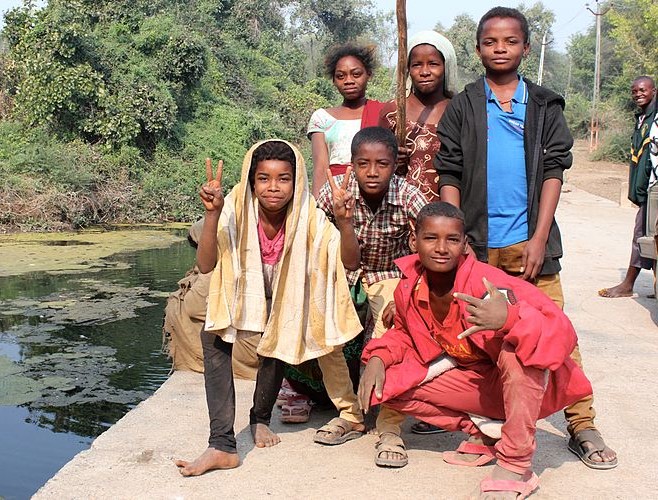In the following article, University of Louisville historian John McLeod surveys illustrative episodes in the long history of the Siddis, or African-Indians (Indians of African Ancestry), dating back to the thirteenth century.
There have been people of African descent in the Indian subcontinent for centuries. Some scholars believe that the Harappans or Indus people, who in the third millennium BCE created one of the world’s first urban civilizations in what is now Pakistan and northwestern India, were of African origin. Whatever the identity of the Harappans, for millennia, ships sailing the Indian Ocean linked East Africa and India. Often their goal was trade, and the existence of flourishing commerce is confirmed by the discovery in southern India of fourth-century CE coins that were minted in the kingdom of Aksum in present-day Ethiopia.
Sometimes African traders settled in India. In the state of Gujarat in western India, there is the tomb of a Muslim holy man called Bava (“father”) Gor; he is said to have been a merchant from Africa who arrived in the seventh century. To this day, Indians of African descent worship at the tomb and at other shrines dedicated to Bava Gor.
The continuous documented history of African Indians goes back to the thirteenth century, when an Ethiopian named Jamal ad-Din Yaqut was a noble at the court of Queen Raziyya of Delhi, at that time the most powerful Muslim state in northern India. (It is sometimes said that Yaqut and Raziyya were lovers, but this story appears only to have emerged in modern times.)
Like Bava Gor, some Africans came to India as merchants. Others were soldiers or travelers. Many were enslaved and were brought to India between the fifteenth and nineteenth centuries by Muslim and Portuguese slave traders. In Muslim-ruled kingdoms of medieval India, particularly in the southern region known as the Deccan, enslaved Africans filled roles ranging from palace maids to military officers and royal confidants. Africans in Goa, Diu, and other Portuguese settlements in India were often in domestic service.
Today, there are an estimated 300,000 people of African origin in the Indian subcontinent. They include substantial populations in the Makran region of Pakistan (including the port city of Gwadar, which was part of the empire of Oman-Zanzibar and then of Oman until 1958), the Indian states of Gujarat, Andhra Pradesh, and Karnataka, and the Indian cities of Delhi, Kolkata (Calcutta), and Mumbai (Bombay).
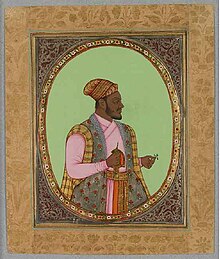
African-Indians were long known as Habshi, Arabic for Abyssinian (Ethiopian). Today, the most common designations are variants of the word Sidi, including Siddi or Shidi. There are several explanations of the origin of this word. The most likely is that it is derived from the Arabic sayyidi, “my lord.” In the sixteenth century, Indian aristocrats of all races were often called Sidi. By the seventeenth century, the word was increasingly confined to aristocrats of African origin, for example, Sidi Masud, who in the 1670s was the prime minister of the kingdom of Bijapur in southern India, as well as a noted art collector. In the eighteenth century, the term was coming into use for anyone of African descent, not necessarily aristocratic, the sense in which it is used today. Many Indians today pronounce the word as Siddhi, which in the ancient Sanskrit language conveys the concept of fulfillment or success.
African Indians have enriched the subcontinent in many ways. Spectacular buildings, some now ruined and some intact, were built by African Indians. One of the most famous is the Sidi Said mosque in the western Indian city of Ahmedabad, which is characterized by windows covered with elaborately carved stone screens. The mosque was built in the sixteenth century by Shaikh Said, the Abyssinian, who was brought to India as a slave and later became a distinguished military commander and Islamic scholar.
African contributions to Indian music range from the distinctive music performed for the dhammal dance in honor of Bava Gor, to African Americans who introduced jazz to India (including Teddy Weatherford, who was a bandleader at the leading hotel in Mumbai in the 1930s), eventually becoming one of the roots of modern Hindi film music.
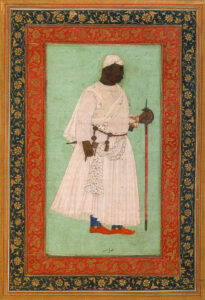
African Indians are also depicted in a wide range of classical “court paintings” that were sponsored by Muslim and Hindu kings and nobles in India between the sixteenth and twentieth centuries. One of the most famous court paintings was commissioned by the Mughal emperor Jahangir, who ruled much of India from 1605 to 1627. It was painted by Abu’l-Hasan, one of India’s greatest artists. The painting depicts Jahangir shooting an arrow through the decapitated head of his Sidi enemy, Malik Ambar. What is interesting is that the painting depicts Jahangir’s fantasy rather than reality: the Mughal emperor fought against Malik Ambar for many years, but far from being captured and killed by Jahangir, the Sidi died in his own bed in 1626, a decade after the painting was completed.
Malik Ambar is an example of an unexpected phenomenon that marked the experiences of some Africans in India: men who, often enslaved when they arrived in India, rose to high office in Indian kingdoms. Malik Ambar (whose original name was Chapu) was born in what is now southern Ethiopia in 1548. When or how he was enslaved is unknown, but in the early 1570s, he was purchased by a man named Chengiz Khan, a fellow Ethiopian. Chengiz Khan had come to India as a slave, but by the time he acquired Malik Ambar, he had risen to the position of prime minister of Ahmadnagar, a Muslim-ruled kingdom in southwestern India. After Chengiz Khan’s death, his widow freed Malik Ambar, who became a soldier. He eventually commanded a body of troops whom he hired out. Then, in 1595, Ahmadnagar was invaded by the army of the Mughal emperor Akbar. Malik Ambar became the leader of the Ahmadnagar resistance. He oversaw the marriage of his own daughter to the young king of Ahmadnagar, and until his death in 1626, he successfully fought the imperial armies of Akbar and his son, Jahangir, and preserved the independence of Ahmadnagar.
Nor was Malik Ambar an isolated example. For many years, the real ruler of the kingdom of Bijapur, Ahmadnagar’s neighbor to the south, was an African named Ikhlas Khan, who is known to art historians as the African most frequently depicted in Indian court paintings.
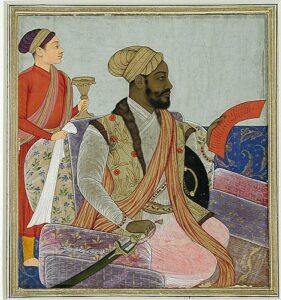
Sometimes African-Indians became monarchs themselves. The Sharqi (“eastern”) dynasty, which ruled much of north India from the city of Jaunpur between 1394 and 1479, may have been of African ancestry. Further east, in the fifteenth century, the Muslim king of Bengal (now divided between India and Bangladesh) recruited some 8000 enslaved Ethiopians to serve in his army and his administration. Over the ensuing years, the Ethiopians grew in power and rose into the nobility of Bengal. In 1487, Ethiopian nobles overthrew the reigning king and seized power, and for the next six years, Bengal was ruled by African kings known as the Habshi (“Abyssinian”) dynasty.
The longest-lived African-ruled kingdoms in India were Janjira and Sachin, both on the west coast. There are several stories about the origins of Sidi rule in Janjira, but it appears that it originated in 1618 when Malik Ambar appointed a fellow African, Sidi Surur, to govern the island fortress of Janjira on his behalf. Sidi Surur’s successors eventually became the independent kings of Janjira and the neighboring mainland. When necessary, they recognized the overlordship of Indian powers, the Mughal emperors in the seventeenth and eighteenth centuries, and the British from 1834 to 1947, but otherwise they ruled their small kingdom (which in the 1940s had an area of 326 square miles and a population of 103,557 people).
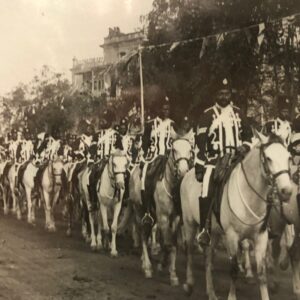
The last king of Janjira was Sidi Mohammad III, who succeeded his father in 1922. Following the end of British rule in 1947, he accepted the supremacy of independent India over Janjira. The following year, along with the rulers of other kingdoms in India, he renounced his sovereign powers so that Janjira could be merged into the rest of India. Sidi Mohammad III died in 1972. However, his son Sidi Shah Mahmood still lives in his ancestral palace on a cliff overlooking the island of Janjira, where he is held in high esteem by the locals.
The other long-lasting Sidi kingdom was Sachin, which with 49 square miles and 26,231 inhabitants, was even smaller than Janjira. Sachin originated in a dispute over the succession to the throne of Janjira. A Sidi prince, Balu Miyan, claimed that he had been displaced following the death of his father, the previous king of Janjira. In 1791 when Balu Miyan renounced his claims to Janjira, in return, he received twenty scattered villages 250 miles to the north, which became the kingdom of Sachin. His family ruled until 1948 when his direct descendant Sidi Mohammad Haidar (nicknamed Balu Miyan II) followed the example of the king of Janjira and transferred his kingdom to the Indian government of India. The current head of the family is Balu Miyan II’s great-nephew, Sidi Mohammad Reza Khan, who, like Sidi Shah Mahmood of Janjira, is highly respected by the inhabitants of his former kingdom.

